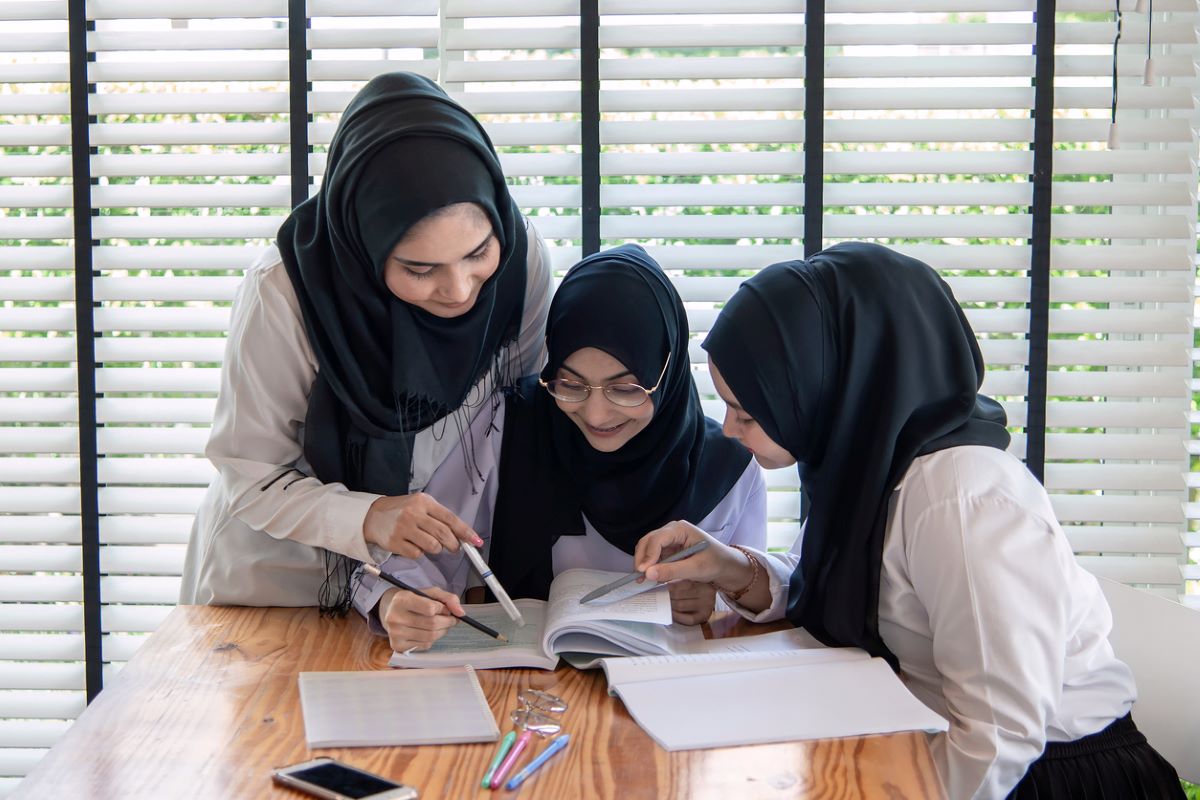Ever since the hijab row broke out and the question of asserting one’s religious identity came up and then acquired centre-stage, I have been haunted by one question. Every person carries within her not one but several identities ~ which of these identities is really worth fighting for? When all other identities are taken away, or are considered unimportant, is it only the religious identity that remains and ultimately defines an individual? And if we allow the religious identity to prevail over all other identities in the name of freedom, what remains of the idea of India as a secular state?
Among the diversity of opinions which the hijab controversy has provoked, none seems to address these questions. It is amusing that a simple piece of cloth can have such astounding power to bring the entire higher education in a state to a standstill, with colleges and universities remaining closed for days.
Advertisement
The issue had first erupted in December in a Karnataka Government college in Udupi when a few Muslim girls were denied entry into their classrooms after they insisted on wearing the hijab and the college refused to let them wear anything other than the prescribed uniform. Fundamentalist elements on all sides and politicians with vested interests got a golden opportunity to inflame passions. As tension rose, the protests spread to college campuses in other towns. Images of students wearing hijabs and saffron shawls, and rallies with placards showing “I love Hijab”, “Hijab is our right, Hijab is our pride” and “Hijab, My Right, My Choice, My Life” started appearing in every fora, played repeatedly over the TV screens, fanning the flames of religious polarisation further and in the process, turning education, which is the major purpose of attending a college, into a minor issue.
As weighty constitutional questions on freedom of religion as defined under Article 25 of the Constitution or what constitutes essential practices in Islam and whether hijab is one started getting debated forcefully, the events attracted international media attention and acquired an international dimension. One Rashad Hussain, Ambassador at Large at the US Office of International Religious Freedom, tweeted that the hijab ban in schools violates religious freedom, forcing the Government of India to reject it angrily by saying that motivated comments were unwelcome.
The matter has finally reached the Karnataka High Court and while it is yet to pronounce a verdict, it was taken to the Supreme Court by Mr Kapil Sibal, who tried his best to get it admitted there. The Supreme Court, however, stuck to its stand to let the High Court first give its decision and steadfastly refused to get drawn into the issue prematurely. Those who are demanding to assert their religious rights argue that there is no harm in allowing the hijab, since it neither disturbs public order in any way, nor hurts the religious sentiments of others.
The opponents say that once this is allowed, the uniform of an institution loses all sanctity; further it will unleash more such demands of which there will be no end ~ today it is the hijab, tomorrow it will be the niqab and the day after tomorrow, it will be the burqa that will be demanded to be allowed in classrooms as an essential part of religious practice.
Public educational institutions are not religious seminaries ~ a classful of burqa or saffron-clad students in a public college would certainly look eerie and absurd. It may be mentioned that the idea behind a uniform is again to assign an identity to a student for grater cohesion, belongingness and pride, above their many individual identities bestowed by social status, religion, caste, creed, etc. Identity is often a doubleedged sword and questions of identity, if not addressed carefully, may undermine social cohesion, create friction and lead to a loss of trust in institutions, hurting assimilation of individual differences into the body politic, especially in a multi-religious, multicultural society like India.
No freedom is absolute and every freedom including the freedom of religion is subject to reasonable restrictions. The Constitution gives broad guidance about these restrictions, but if the idea is to instil a spirit of national integration based on the Constitutional values which are spelt out in the preamble, would it be served by allowing the symbol of any religion within the precincts of an educational campus? Or would it create religious polarisation within the campus, breed mistrust among students belonging to different faiths and engender competitive assertions of one’s faith through wearing of religious symbols? Would it be good for our students or hurt the objectives of education itself? These vital questions are getting drowned in the din of politicians crying hoarse that our daughters are being denied both education and religious freedom by a majoritarian mindset that dominates every echelon of our governance.
Majoritarianism may be present elsewhere, but perhaps that is not at the heart of the issue here. This is not an issue that has cropped up for the first time. In 2016, to check unfair practices at the All-India Pre-Medical Entrance Test, the CBSE had advised the candidates to “wear light clothes with half-sleeve, without large buttons brooch/ badge/flower etc., with salwar/ trouser”. A Muslim student, Amnah Bint Basheer, approached the Kerala High Court arguing that the Quran mandates women to “cover their body, except face, with loose garments” and that the dress code set by the CBSE infringed upon her fundamental right under article 25.
A single judge bench of Justice A Muhamed Mustaque took a balanced view in the matter. Without quashing the CBSE dress code, the Judge allowed female Muslim candidates to wear hijabs and long-sleeved dresses in accordance with their religious practices; he only asked the CBSE to take additional measures in respect of such students, like requiring them to report earlier for checking and allowing only women invigilators to frisk them.
In 2018, there was the Fathima Tasneem vs State of State of Kerala case which is being cited now as a precedent. A school run by a Christian convent in Thiruvananthapuram refused to allow two Muslim girls to wear hijab and full-sleeved shirt as part of their uniform. The same judge in that case too ruled that the larger collective right of the institution was greater than the individual rights of the petitioner, and it is entirely for the institution to decide which dress to allow for its students.
The court here was only trying to balance the right of institution ~ a private minority institution at that ~ to freely manage its affairs against the right of freedom of religion of certain individuals. Though the context is a little different now ~ a government college is not a private minority institution ~ the question probably is one of priority of plural interests over individual interests and rights, which is also the essence of democracy. A full bench of the Karnataka High Court is presently considering the matter. I am sure the learned judges will dissect every aspect of the case and carefully weigh and measure the arguments on both sides before pronouncing their verdict. In their reasoned interim order, they have clarified that a secular state like India does not identify itself with any religion.
“Every citizen has the right to profess and practise any faith of choice, is true. However, such a right not being absolute is susceptible to reasonable restrictions as provided by the Constitution of India. Whether wearing of hijab in the classroom is a part of essential religious practice of Islam in the light of constitutional guarantees, needs a deeper examination”, they said in their interim order, while restraining all students from wearing hijabs or saffron attire, and observing that the “interest of students would be better served by their returning to the classes than by the continuation of agitations and consequent closure of institutions.”
In its judgment in the S R Bommai case of 1994, the Supreme Court had observed that “religious freedom is the hallmark of pluralism and inclusiveness. It is meant to advance social harmony and diversity”. Every judgment by every court of the country has always upheld the spirit of this pluralism and diversity and frowned upon practices that undermined these. Perhaps more than whether an attire constitutes an essential practice of a religion or not, it is this test of pluralism ~ whether a religious practice advances the cause of “social harmony and diversity” ~ that is more relevant here.
Many Muslim nations ~ like Kosovo, Azerbaijan, Tunisia, Morocco, Lebanon, Egypt and Syria have put restraints on the hijab, niqab and burqa in varying degrees for different purposes ~ Syria has even banned the niqab in its universities since 2010 as being a threat to the country’s secular identity and to fight against radical Islam ~ not to talk about the secular western nations like Russia, France, Bulgaria, Belgium, Switzerland, Denmark, etc., which have also put similar restraints on Islamic dress codes.
It depends on determining our priority between the conflicting objectives of individual choices and liberties, institutional freedom, and plurality and secular ethos of the nation. Their lordships can be trusted to optimise between these conflicting rights and give the judgment that will protect the idea of India as enshrined in the Constitution.
(The writer is a commentator, author and academic. The opinions expressed are strictly personal)











